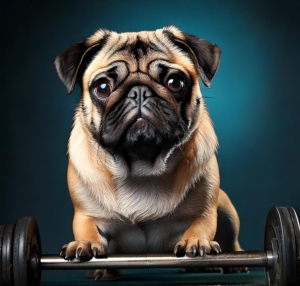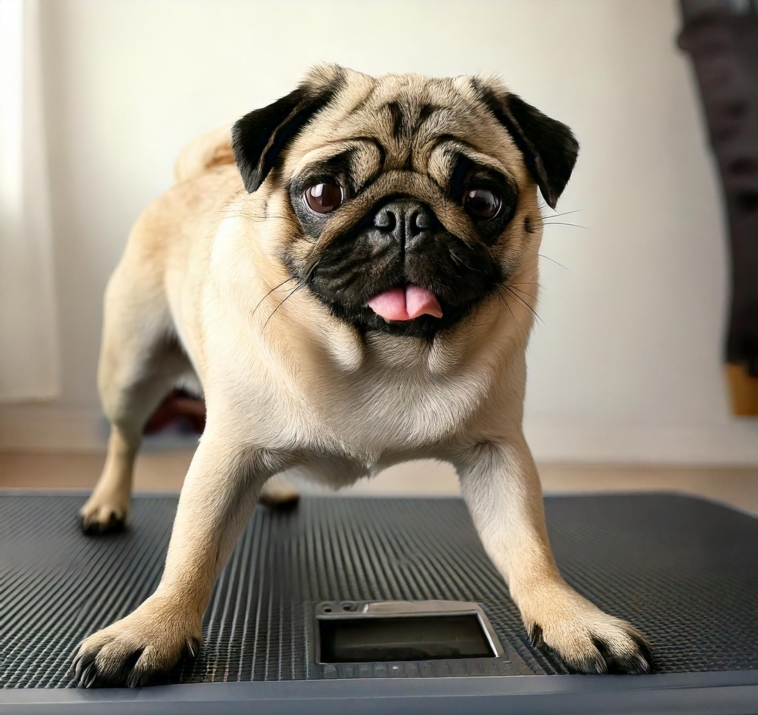Maintaining a Healthy Pug Weight: A Guide to Keeping Your Chunky Little Gremlin Fit
Before we get started on the exalted mission of trimming your pug’s waistline, a few basics, please. Pugs are not merely full-time snack-hounds—they’re also small, mushy dogs who are best suited to weigh somewhere between 14 and 18 pounds. Beyond that, and you’ve pretty much got yourself a meatball with legs covered in fur.
Also, yes—pugs do look like they were specifically designed for comfortable, bougie homes with velvet sofas and high-thread-count linens. But no matter how fancy or peasant your life, healthy weight is important.
What Makes a Pug Tip the Scale?
1. Age:
Puppies are chewing machines driven by energy. Older pugs? Sleepy potatoes, not much.
Feeding requirements alter as they age—sort of like us.
2. Gender:
Male pugs are ever so slightly bulkier than ladies. In other words, he’s not fatty he’s simply “big-boned.”
3. Genetics:
If the parents of your pug were chonks, chances are that your pug inherited the thick gene as well.
How to Tell If Your Pug Is Fit or Fluffy
Visible Waistline
Peak from above. Do you see a waist, or is it just one fabulous sausage shape?
Feel the Ribs (Don’t See Them)
You should be able to feel your pug’s ribs like a secret treasure—not see them standing out like a skeleton.
Energy Level
Healthy pugs are playful, naughty, and able to have spontaneous zoomies at 2 AM.
🩺 Pro Tip: Take them to the vet occasionally. They’ll thank you (in heavy breathing and squinty smiles).
Why Pug Pounds Matter (and We’re Not Talking Currency)
- Longer Life: Healthy pugs live longer. More birthdays, more snuggles.
- Happier Joints: Less weight = less stress on those little legs.
- Easier Breathing: Pugs already have trouble breathing. Add excess fluff, and it’s like breathing through a straw. underwater.
- Healthier Hearts: Obesity provides their hearts with added cardio they didn’t ask for.
- Better Digestion: Healthy pugs poop like champs. Enough said.
- All-Around Sassier Energy: Happy pugs are more energetic, more playful, and much more likely to terrorize the cat for kicks.
Is Your Pug Packing Extra Pudge? Look Out for These Signs
- Chubby Chest + Belly + Butt – The Fat Triangle.
- Panting Like They Just Completed a Marathon After Getting Up
- “Meh” Attitude Towards Playtime
- Difficulty With Stairs or Looks Like a Couch Potato with Legs
- No Visible Waist – Just a Loaf with Legs

Let’s Talk Food: Your Pug’s Not a Garbage Disposal
What to Feed:
- Protein: Chicken, fish—actual animal material. Not enigmatic “meat byproduct.”
- Good Carbs: Whole grains. Not fillers fit for cereal.
- Healthy Fats: A dash of flaxseed oil or fish oil. Wonderful for coats, joints, and preventing pug dandruff.
- No Table Scraps: They don’t require your pizza crust. Seriously.
- Water Bowl: Fill it up. Hydration > temptation.
Meal Plan: Because Pugs Will Eat Anything If You Let Them
- Choose Premium Pug Food: Read the labels. If it sounds like something you would not eat in the apocalypse, do not give it to your pug.
- Watch Portions: Measure it. “Eyeballing it” = pug becomes fat.
- Establish Meal Times: Stick to a routine. Pugs are clock-watchers in disguise.
- Light on the Treats: Treats should be 10% or less of daily calories. Pugs believe 110%, but do not listen to them.
- Add Veggies: Green beans and carrots are excellent choices as snacks which will not turn your pug into a puffball.
- Ask Your Vet: Let the professionals chime in—literally.
Work It, Pug! Exercise Tips for the Built-In Couch Potato
- Walks: Brief, sweet, and often. No hikes unless you’re bringing them back.
- Puzzle Games: Get them thinking and moving. It’s CrossFit but for dogs.
- Swimming: Low impact and high fun. Just don’t forget the life jacket—pugs aren’t exactly natural-born swimmers.
- Warm Up + Hydrate: Because pulled muscles and dry tongues are real.
Indoor Olympics: Keeping Your Pug Active Without Leaving the Couch (Much)
- Treat Puzzles: Keeps brain and body active.
- Hide & Seek: Hide toys and allow them to be a detective.
- Stairs (Supervised): Climbing stairs burns calories. Descending? Not so gracefully.
- Training Time: Sit. Stay. Roll over. Burn calories performing tricks.
- Laser Pointers: Inexplicable entertainment. Just be sure not to shine it into their eyes—or yours.
Track That Chub: Monitoring Weight Without Being a Helicopter Parent
- Weigh them bi-weekly (with a digital scale, not your bathroom guess-o-meter).
- Record everything food, weight, activity, treat bribes.
- Suspect strange patterns? Time to call the vet.
- Prevention > Drama. Not about fat-shaming it’s about health-saving.
Pug Don’ts: Rookie Mistakes That Lead to Chunky Trouble
- Overfeeding: “More food = more love” is a myth.
- Guesstimating Portion Sizes: Measure it or face the possibility of raising a furry bowling ball.
- Feeding Table Scraps: That cheeseburger is a heart attack waiting to happen.
- Forgetting Exercise: Lazy today, waddling tomorrow.
- No Scale? No Clue: Ignorance is not bliss when your pug’s waddling like a penguin.
- Incorrect Diet: Match their food to their age, size, activity, and drama level.
Weight Control Power-Ups (Use With Caution)
- Omega-3s: Loose joints and happy mood.
- Probiotics: Digestion that doesn’t sound like a podcast.
- L-Carnitine: Fat burner (and excuse maker).
- Glucosamine: Joints that can dance again.
BUT! Always consult your vet before making your pug into a supplement stalker.
Dieting a Pug Without the Drama
- Put a muzzle on your pug if he believes begging is a full-time profession.
- Hide human food as if it is national treasure.
- Vet-approved treats ONLY. Not leftover bacon bits
The Fit Pug Life: True Stories of Chub-Free Champions
- Jenny’s Fido:
“Fido became more energetic and more playful in a matter of months.”
Translation: Less napping, more zoomies. - Tom’s Trick:
Began walking his pug every day and ceased with the table scraps toss like a vending machine. Ah, portion control does the trick! - Karen’s Chronicles:
Monitored her pug’s diet like a food blogger and even employed a trainer.
“Rocky loves the new active lifestyle, and his weight is where it needs to be now,” she smiles most likely while Rocky runs circles around her.
Long-Term Strategy: Keep Calm & Walk the Pug
It’s easy:
- Hold on to daily walks.
- Measure the food.
- Skip the snacks.
- Vet visits are not negotiable.
- And, please, no more pizza crusts on the floor.
With a bit of effort (and a lot less cheese), your pug can go from flabby to fabulous—while remaining the adorable loaf you love and cherish.




